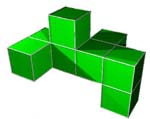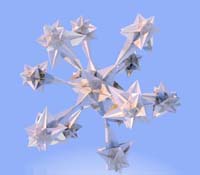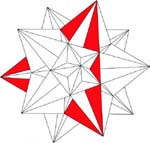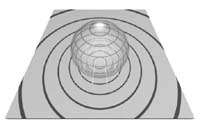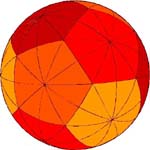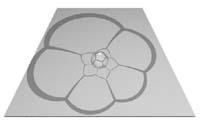Not only hypercubes
In these pages there are several pictures, animations and information on hypercubes. One might think that hypercubes are the only objects in four-dimensional space.....: it is not true! It is only the simplest object and, therefore, it is easier to describe it. In four-dimensional space there is a "zoo" of polytopes which is richer than the "zoo" in three-dimensional space.
To begin with, there are six regular polytopes, which are the analogue of the five regular polyhedra in three-dimensional space: one of them is the hypercube.
There are other possibilities as well. One can define and investigate various families and objects in the 4D world as in the 3D world exist polyhedra , prisms and pyramids, uniform polyhedra and star polyhedra.
Here you find one of the animations on a regular star polytope. Precisely, it is the analogue of the great icosahedron . In the animation this polytope goes through a 3D world. We see a section of it as if an inhabitant of flatland saw all the different polygons, which take shape in his/her flat world, when a star icosahedron goes through it.
It is not surprising that one sees several “detached” polyhedra at the beginning. They look like the great star icosahedron. If we imagine taking a section of the great star icosahedron with a plane which is orthogonal to the direction vertex-vertex, one would see a regular star with five points. If we cut it with a plane which is orthogonal to the direction face-face, one would see three "detached" stars at the beginning.
They would not be regular stars but they would appear a bit deformed.
What else can we find in four-dimensional world? Can we find the analogue of surfaces? Spheres, for instance? Of course, we can. Furthermore, the analogue of surfaces yields a variety of shapes, which is richer than the relative monotony of surfaces.
Let us talk here about the sphere. The hypersphere in four-dimensional world can be defined like the sphere in 3D (and the circle on the plane), that is to say, like the set of points with the same distance from a given point, which is the center of the hypersphere. How can we imagine it? In a sense, our world is a hypersphere as long as we "close it up" with a point at infinity.
To explain this claim, suppose you put a sphere on a plane and next project the sphere on the plane from the North pole (the antipodal point with respect to the tangency point betweeen sphere and plane). We obtain a bijective correspondence - the so-called stereographic projection - between the whole plane and the sphere except the North Pole. Analogously, there exists a correspondence between the 3D space and a hypersphere with a point removed - we still call it stereographic projection.
We can project onto the 3D space (and so "see") some objects contained in a hypersphere. This is the principle on which the following animations are based. In this one, imagine to project the 120-cell on the circumscribed hypersphere (as you can “enflate” a dodecahedron on the circumscribed sphere . Via the stereographic projection, one can pass from a hypersphere to 3D space and imagine to "get into" a 120-cell.
Of course, the faces are not regular dodecahedra, just as the faces of the dodecahedron, which is here drawn, are not exactly pentagons; these are the drawbacks of projections....!
